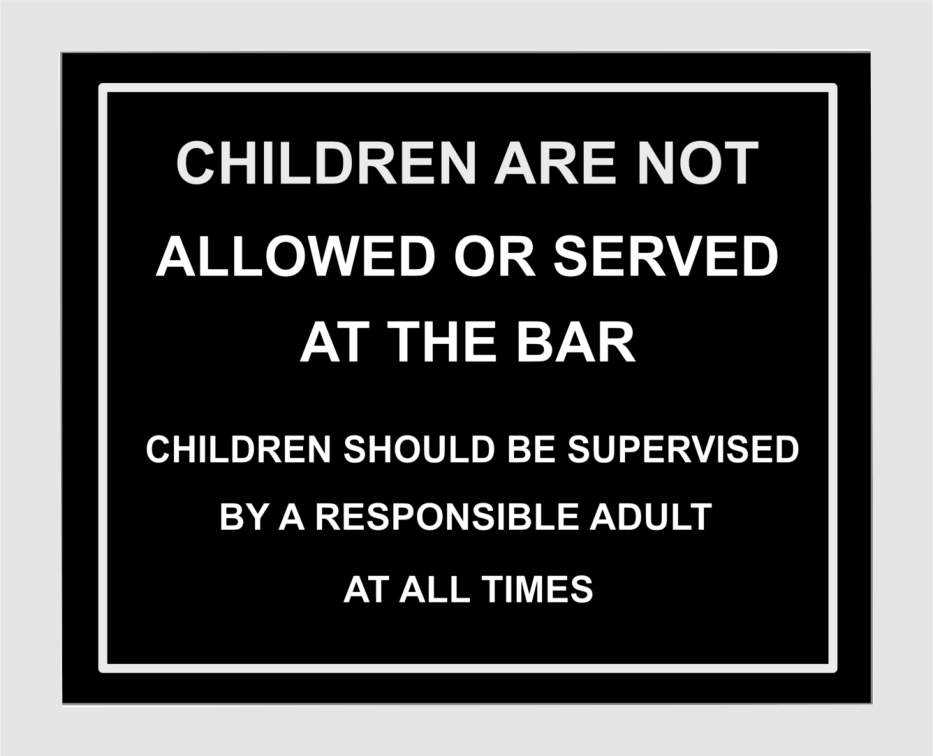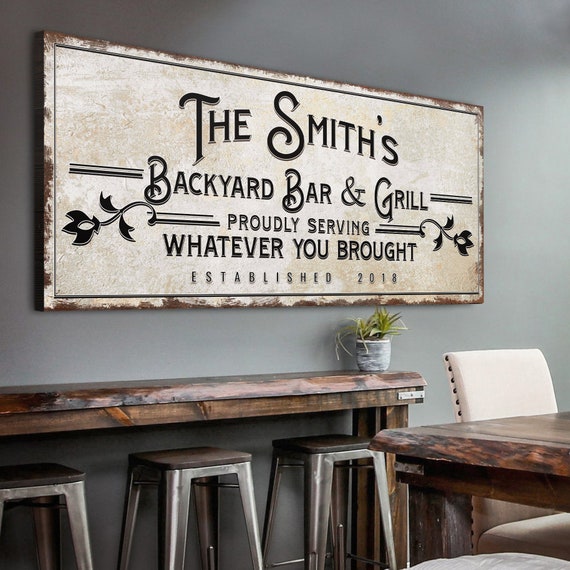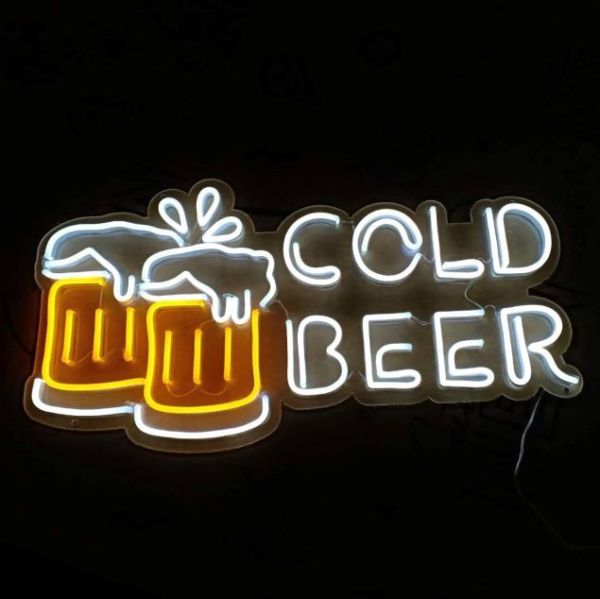New Tips On Deciding On Gin Bar Signs
New Tips On Deciding On Gin Bar Signs
Blog Article
What Is The Difference Between Bar Signs In Terms Of Size?
Bar signs differ in size depending on their use, their location, and the overall design aesthetic. This is a brief overview of how the differences in size affect the function and aesthetics of bar signs: 1. Large Signs
Purpose: To serve as a focal point and draw attention.
Uses: Exterior signs that are main branding signs, or feature walls.
Location: Usually, it is placed above entrances, on large walls, or outside the bar area to attract patrons.
Examples: huge neon signs such as vintage-style signs or mural signs.
2. Medium Signs
Uses: To provide information or decorate the space without dominating.
Uses for: Signs for direction, menu boards, as well as promotional display.
Location: Located in a position that is easy to view but not overwhelming for example, behind the bar, above seating areas, or on walls with features.
You can make use of decorative signs or even metal signs to advertise your bar.
3. Small Signs
The purpose is to add delicate decorative elements or give specific details.
Uses for table signs, ornaments or labels.
Placement : on tables or on shelves where close-up view is required.
Examples: Small-framed drinks cards or quotes.
Size Aspects
Visibility
Large Signs - Designed to be visible from afar, they are ideal for attracting passing traffic and establishing the bar's presence.
Medium signs: Offers essential information in a space-efficient manner, without overwhelming the decor.
Small signs are ideal for intimate information and close-up details, enhancing the patron's experience from a distance or tabletop.
Proportion
Large Signs: They should be proportional to the size of the space to prevent overwhelming smaller areas. Best suited to open or large-sized environments.
Medium Signs: Ideal for use in the interior They can be positioned anyplace.
Small signs: Ideal way to add depth, and they fit neatly into small spaces.
Impact
Large-sized signs makes a bold and imposing statement. This can be an important aspect of branding. Bar signs are utilized to establish a specific tone.
Medium Signs: Strive to achieve an ideal balance of decor and visibility, while providing crucial information.
Small Signs : These signs add detail and charm that creates an incredibly rich and multi-layered visual experience.
Practicality
Large Signs: Need massive mounting solutions, and could cost more due to size and materials.
Medium signs offer more flexibility when it comes to design and are simpler to put up.
Small Signs are extremely versatile and easy to replace, perfect for settings that are dynamic, such as bars that change menus frequently or promotional offers.
Functionality
Large Signs : They are designed to increase visibility, attract attention and practicality.
Medium Signs are both functional as well as decorative. They provide vital information as well as enhance the visual appeal.
Small Signs: Mainly used for providing information in detail, but also contribute to the overall theme and decor with a subtle approach.
The ideal size for bar signage will depend on the purpose for the sign, its location inside the bar, as well as the way it is perceived by the customers. This ensures that the sign's contribution to the atmosphere of the bar and operational requirements. Read the recommended pub signs tips for blog examples including bar wall signs, large personalised bar signs, personalised outdoor bar signs, personalised signs for home bar, the staying inn bar sign, signs for garden bar, to the pub sign, the staying inn pub sign, hanging pub signs for sale, make a bar sign and more.
What Are The Distinctions Between Bar Signs With Regard To The Installation And Mounting?
The type of bar sign, its dimensions and weight, its place of installation, and their function will determine the way it's mounted and put up. This article will offer details on the various mounting and placement alternatives for bar signs. Wall-Mounted Signs
The main characteristics are that it is fixed directly on walls.
Methods:
Screws & Anchors: Often used on heavier signs (metal & wood) to ensure stability.
Adhesive strip: For temporary or lighter installations and signs (foamboard and acrylic).
Brackets can be used to display signage that extends beyond the wall.
Uses: Indoor decor, menu boards, directional signs.
Benefits: Secure, flexible and allows for a prominent display.
Negatives: May cause damage to walls, and are difficult to move.
2. Hanging signs
Characteristics Suspended overhangs or ceilings.
Methods:
Chains - strong, adjustable and perfect for large signage.
Cables: Modern designs usually make use of cables to give them a sleeker appearance.
Rods: Provide a rigid support structure.
Uses: Ceiling decor, directional signs, overhead promotional signs.
Advantages : Uses vertical space effectively and can be a decorative feature.
Advantages: Needs strong ceiling anchors, can sway when not properly stabilized.
3. Freestanding Signs
Specifications: Does not connect to any structure. Supported by a base or stand.
Methods:
A-Frames are portable and foldable. Often used for sidewalk advertising.
Pedestal Stands: Stable base, ideal for indoor use.
Post and Panel: Used for large, permanent signs.
Uses: Outdoor advertising, indoor directional signs, promotional displays.
Features: The product is portable that is versatile and easy to position.
Advantages
4. Window Signs
Features: Directly connected to windows.
Methods:
Suction cups are simple to put in and remove. They're ideal for signs with a lighter weight.
Adhesive Glass: Can be directly applied to the surface of the glass. It is ideal for decals, graphics, as well as other graphics.
Static Cling: Reusable, non-permanent adhesive that is easy to take off or apply.
Uses for: Promotional messages and branding, as well as hours of operation.
Benefits: Increases space in windows. Very visible from the outside.
Limitations: Could be in the way of sunlight, but is limited by the dimensions of the window.
5. Edge-Lit and Backlit Signs as well as Edge-Lit Signs
Characteristics: Incorporate lighting within the sign's structure.
Methods:
Wall Mounting with Electric Connections: It requires a secure connection and electrical connections.
Suspended by Power Cables combines hanging method with integrated light.
Examples include high-visibility branding for menu boards, or decorative elements.
Advantages include enhanced visibility and attractive illumination.
Installation is more challenging and requires electricity.
6. Temporary Signs and Portable Signs
Features Designed to be simple and quick setup.
Methods:
Pop-up Stands: Lightweight and compact.
Banner Stands: Roll-up or retractable designs.
It is used for promotions, events and seasonal decorations.
Benefits: Simple and quick set-up, easy to transport.
Advantages: Not as durable, might not be as sturdy.
7. Magnetic Signs
The characteristics of magnetic force are employed to attach objects.
Methods:
Magnet Strips: Adhere to the back side of the sign.
Magnetic Boards - Signs are affixed to the metal surface.
Uses For: Temporary notices and menu boards that may be altered.
Advantages Easy to change. No permanent fixtures are required.
Limitation to magnetic surfaces can cause it to be less secure.
8. Projection signs
Features Highlights: Project images or words using light.
Methods:
Projectors mounted on mounts can be affixed safely to ceilings or walls.
Portable Projectors: Placed on stands or on other surfaces.
Displays with dynamic content are used for events, promotions and other promotional activities.
Advantages: Easily changeable content No physical sign required.
Advantages
Tips for mounting and installation
Weight and Size
The heavy signs (Heavyweight): They require more durable mounting solutions, such as bolts and screws.
Light Signs can be created with less complex methods, like suction cups or adhesive strips.
Durability
Permanent Signs: Use a more secure and durable method of mounting.
Temporary Signs - Select a method that allows for easy removal and repositioning.
Location
Indoor: More flexibility with materials, methods and resistance to weather.
Outdoor: Materials and mounting should be weather-resistant to withstand the elements.
Aesthetics
Concealed mounting: This option gives a more professional appearance by hiding the hardware.
Decor Hardware: Enhances look of the sign.
Accessibility
Simple Access to Changes: Essential for signs that require regular updates, such as menu boards.
Security: Ensures the signs aren't easily altered with or snatched.
Take note of these aspects when selecting the mounting and installing methods to install your bar. You can be sure that these methods are compatible with both functional and aesthetic requirements. View the recommended bar signs for home bar hints for site tips including pub bar signs for sale, bar signs for home bar, modern pub sign, personalised outdoor pub signs, bar sign design, home pub signs, hanging bar sign, pub signs made, pub signs for home bars, personalised metal bar signs and more.
What Is The Difference Between Budget Signs And Bar Signs?
Bar signs can vary widely in price, based on factors such as the size, materials, complexity, customization, and installation requirements. What are the differences between bar signs? Material Cost
Low-cost materials: Signs created from foam board and vinyl decals are generally less expensive.
Signs that are constructed from premium materials (metal or wood) as well as customized cut glass) are costly due to the costs of the materials as well as the workmanship.
2. Design Complexity
Simple Designs Signs featuring simple designs, basic text, and basic graphics usually are less expensive to create.
Complex Designs: Signs that have intricate designs, custom typography, or special effects (e.g. neon or LED) require more time and knowledge and thus increase the cost.
3. Customization
Standard Options: Off the shelf or already-designed signage templates are generally cheaper than custom-designed signage.
Customized Features. In addition costs customized logos, colors and finishes can provide distinctive branding options that are tailored to the personality of a bar.
4. Size and Scale
Tabletop Signs, Decals or Small Wall-Mounted Signs generally cost less due to lower production and material Costs.
Large-Scale Displays: The use of large signs, marquees for outdoor use and displays with lights requires more materials, labor and cost.
5. Lighting
Signs that are not illuminated: Signs with no illumination typically cost less because they need fewer components and electrical power.
Illuminated Signs. Neon, LED and backlit signs are more expensive due to the wiring, additional materials and the energy required.
6. Installation
DIY Installation: Signs which can be easily put up by the bar owner or staff are more cost-effective than those requiring professional installation services.
Professional Installation Signs that are huge or complicated may require the assistance of a professional for installation. While this may raise the price of the sign, it also ensures security and a proper installation.
7. Quantity
Bulk orders may qualify you to receive discounts on quantity or per unit cost when compared to single orders.
Single Orders - Buying one-off signs or customized pieces could be more expensive, due to cost of production and set-up.
8. Maintenance and Long-Term Costs
Low-Maintenance / Long-Lasting Signs signs that require minimal maintenance and last for a long time could provide significant cost savings over the long term.
Signs that need a lot of care: Signs that require intricate designs, delicate materials or particular needs for maintenance and repairs could be more costly.
9. Budget allocation
Budget Allocated: Setting the budget allows bar managers and owners to allocate their money on the most important elements like branding in terms of visibility, endurance, etc.
Cost-Benefit Analyses: Through analyzing the return on investment of various signage options, bar owners are able to make a more informed decision about how to spend their money.
Options for financing
Upfront Payment: Paying upfront for the signs is cheaper than financing them with loans or installment plans. This will save you finance charges as well as interest charges.
Financing Plans: Certain signage providers offer financing options or payment plans that help spread the cost of signage over time, which makes higher-end options more affordable to bar owners with a limited initial capital.
Be aware of these elements when you are working within your budget when choosing signage that enhances customer experience, communicates your brand identity and enhances the value of your establishment. Have a look at the top personalised bar signs for more info including bar signs, outdoor home bar signs, bar signs for home bar, personalised home pub sign, personalised signs for bar, hanging pub signs for sale, personalised pub signs, outdoor home bar signs, bar sign design, bespoke bar signs and more.